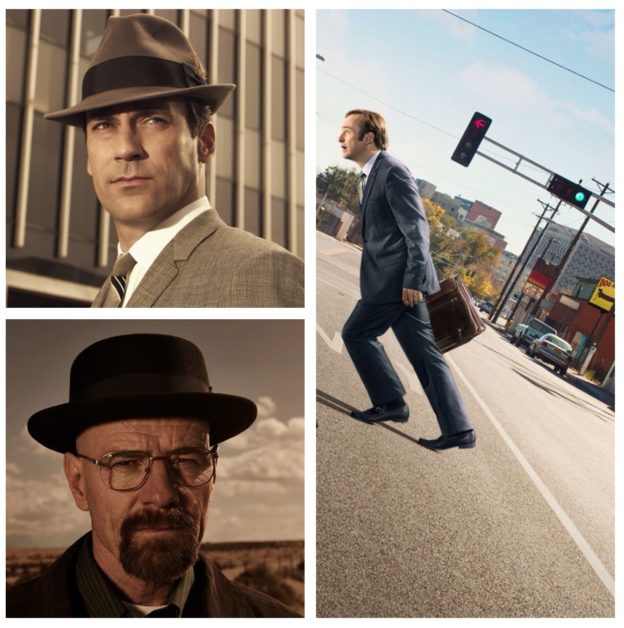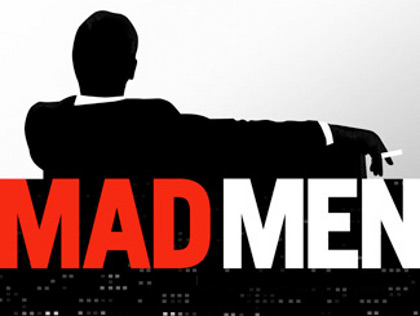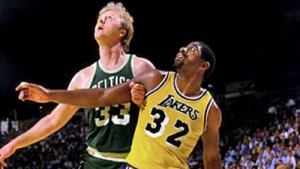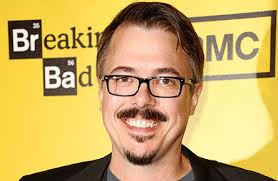And there’s whiskers on m chin.
Tag Archives: Don Draper

Better Call Saul: The Olive Branch — or Mirror — to Breaking Bad and Mad Men
Warning: Spoilers don’t about; they lurk)
As the unofficial Assistant to the Manager of the Vince Gilligan Fan Club, I have been watching Better Call Saul religiously — and by extension, reruns of my two favorite shows, Breaking Bad and Mad Men.
And it has reawakened an inner-torment, one that perhaps other rabid fans of BB/MM suffer: Which of the dark odysseys is the better drama? Matthew Wiener’s tale of Wall Street executives in the 1960’s, or Gilligan’s tale of a high school meth teacher gone horribly astray?
And in confession, I wax and wane. Some days, the nod to goes to Don Draper, the suave, womanizing alcoholic of Man Men. On others, Walter White reigns as ultimate anti-hero, the cancer-stricken anchor of Breaking Bad. One thing remains clear: For all the brilliance of Saul (and there is much), BCS is a shadow of both.
That’s not a criticism of Saul; even a shadow of Gilligan’s breakthrough show eclipses all other TV. But its shadow remains looming, given the intellect of both predecessors.
But recently, I came to a realization: Saul is actually an homage of both shows, which are fraternal twins.
Consider the core of Mad Men and Breaking Bad:
- Both shows are about middle-aged men, both hesitant to reveal their real ages and inner fears.
- Both center on addiction: Draper to alcohol, White to power.
- Both characters use the trust of women and youth to enable their respective demises.
- Both aired on AMC, once a source of original TV.
- Most importantly, both shows are paeans to the art forms that preceded their own.
It’s that final point in which the shows chose particularly different (yet equally eloquent) paths to reach their finales.
Let’s start with Mad Men, which launched on AMC from 2007-20015 and tells the story of high-powered Wall Street executives through the 1960’s. Breaking Bad, meanwhile, aired from 2008-13 and tells of a high school teacher who employed a former student to cook and sell meth.
Purists will argue that Mad Men deserves more credit because it arrived first. But, in truth, abstract art must always follow representational art, lest it lack source material.
And that is the defining difference — and link — between the shows: Mad Men is representational art, Breaking Bad abstract art.
Consider: Mad Men is time-specific. It revels in an exact era, and is a veritable Hollywood version of history. From the moon landing to the hippie generation to the assassinations of MLK and the Kennedys, Mad Men is intrinsically tied to America’s emergence into the 70’s. And it relies on specific Hollywood influences, from Billy Wilder’s The Apartment to The Planet of the Apes to Stanley Kubrick’s 2001: a space odyssey (there’s even an episode entitled The Monolith).
Breaking Bad, meanwhile, is more abstract, centering on the timeless theme that absolute power corrupts absolutely. It also relies on an era in Hollywood: the Western (Gilligan is an admittedly proud wannabe gunslinger). Gilligan peppers the series with showdowns informed by The Good The Bad and the Ugly, John Ford and Once Upon a Time in the West. Gilligan also names an episode after a classic story, Ozymandias, the Shelley poem about how how all kingdoms must eventually fall.
Even the shows feature parallel-if-opposite finales: Mad Men ends with the feel-good endings of the 60’s shows it honored: Peggy and Stan find love; Roger settles on a woman; Joan launches her own business; Peter and Trudy reunite. Even Don finds a heroic farewell: coming up with the ad campaign to Coca Cola’s iconic commercial rendition of I’d Like to Teach the World to Sing.
Breaking Bad, meanwhile, in classic identical-yet-opposite twin brother fashion, says goodbye in abstract gray: Walter White dies in a pool of his own blood. Jesse Pinkman busts through the chain link prison of his captors, simultaneously laughing and crying at his freedom.
There’s no arguing the artistic brilliance of both, just as there’s no denying Saul‘s cleverness in serving as a cousin to both, toying with prequel and flashback tropes in honor of its ancestors. And, like in most families, cousins are great. But they lack the fire of true siblings.
Still, it raises yet a new inner-torment.
Are Mad Men and Breaking Bad rival twins, or the other sides of the same face?

A Farewell to Don, Walter, Omar, and All Those Against the Grain
Ask me my favorite television show, and I’ll blurt out “Breaking Bad!” before you can get to “…of all-time.”
But I have to concede. Mad Men, which begins its final arc Sunday, may be TV’s greatest drama.
The difficulty is in separating the two, favorite from greatest. Our inclination is to defend our passions as quantifiable, as if to validate an opinion. My father’s favorite basketball player was Larry Bird, as is mine. I remember dad spending, literally, hours explaining why Bird was the greatest of all-time: the best passer, the most versatile, toughest and hardest working employee of the NBA.
But I’ve come to acknowledge that Bird’s (and my) former arch nemesis, Magic Johnson, as the better player. More head-to-head victories, more championships, more influential in the game we know today. Even taking a learned path in life. But that’s okay. I’ve quit trying to argue my love as something empirical. What’s wrong with conceding a fanaticism — for a show, a drawing, a person, a poached egg — followed just as openly by a confession that what we love most may be flawed, human, non-sensical, perhaps even broken. Does that diminish a devotion? Surrender a defense?
But that’s okay. I’ve quit trying to argue my love as something empirical. What’s wrong with conceding a fanaticism — for a show, a drawing, a person, a poached egg — followed just as openly by a confession that what we love most may be flawed, human, non-sensical, perhaps even broken. Does that diminish a devotion? Surrender a defense?
So in deference to Walter White: You are my antiheroes of antiheroes. I am your Jesse. I sizzle the glass with you.
Yet, Don Draper and Mad Men could be the greatest feat in television history.
Consider other dramas regarded legendary: Breaking Bad, The Sopranos, The Wire, ER, Law & Order, The West Wing, 24. All, as do 90% of today’s television dramas, subsist on crime, law (including making) or medicine. It makes sense. Those are exciting worlds, full of irresistibly low-hanging dramatic fruit.
Now imagine the pitch that Matt Weiner must have made to AMC for Mad Men. “It’s a show set a half century ago, in a New York ad agency. We’ll get into specific ad strategy — for Kodak, Lucky Strike, Playtex, Utz potato chips, Sno Ball and Ocean Spray, along with (literally) 76 other real-name clients.” Oh, and it’s a no-name cast, with no crime, law or medicine for subject matter.
That it would earn network approval and an eight-year following is about as miraculous as landing Conrad Hilton’s trust (which Don did, briefly). And much ink and megabyte will be spent praising the show for its look and fashion (all deserved) as well its now-known stars (deserving as well).
But let’s recognize its sheer artistry for a moment, if not first. Consider the ad pitch for the folks at Kodak, in season 1, episode 13, for an episode called The Wheel, a what-if with Draper as pitchman for the carousel projector.
Lady Lazarus, from season 5, episode 8, is as dark and artistic as the Sylvia Plath poem that inspired it, just with a kick ass Beatles finale. (Sorry about the Spanish subtitles; it appears to be the only video of it on the World Wide Intertubes.)
And that’s what makes the show understatedly deft, that straddle between detail and tedium. Sure, it’s stylish and a bit too beautiful. But throughout you’ll see artistic touches — and outright show-long homages — that no show but The Simpsons would dare broach, from Dante’s Inferno to Stanley Kubrik to author Philip Roth. In fact, Don Draper is simply a rendition of the protagonist in Roth’s Portnoy’s Complaint, about an impossibly handsome Lothario who can’t fill his cavernous soul with his conquests. (And wouldn’t that be a kick finale, if the entire show were a flashback as Don spills his guts to a shrink?)
The show also differed in its treatment of time. Normally, shows dread time like Dracula at sunrise. Look at 24, a season created out of one day. M*A*S*H lasted longer than the Korean War. Breaking Bad pretended six years was two; The Simpsons has been on a quarter century, and Maggie is still an infant not yet talking.
Mad Men, on the other hand, bounded through the 60’s as if were tripping acid. Smack into MLK’s and Bobby Kennedy’s assassinations, Nixon, the Vietnam War, the counterculture movement. If most dramas focus on a singular, familiar place — a bar, a coffee shop sofa, a triage unit— Mad Men concerned itself with an era, often brutal. That’s unheard of for an industry whose limited view on time usually includes a future with a zombie apocalypse.
The show had its failings. Like the 60’s literature that littered i story lines, Mad Men can’t help but paint most women as mothering, smothering or emasculating. And no entertainment has glamorized smoking this much since Sergio Leone spaghetti Westerns.
But in bidding farewell to the womanizing, alcoholic Don Draper, we also wave to a vanishing TV breed: the antihero. Perhaps reflecting the mood of a nation already somber by real-life events, execs seem to favor the lantern-jawed heroes of late, particularly when they don spandex. Tony Soprano, Dexter, Mr. White, Omar Little  (you’ve really got to see him in The Wire) all salute you from television’s cloud circuit, where antiheroes appear headed.
(you’ve really got to see him in The Wire) all salute you from television’s cloud circuit, where antiheroes appear headed.
I know you’re a doomed drunk, Don. And Mad Men’s outer-shell shiny emphasis on advertising was really an inner reflection of how we see ourselves. Or, more importantly, want to see ourselves.
Still, through your Old Fashion-addled, oversexed, orphaned logic, you have come upon something profound. That, at our best, we are all antiheroes: flawed, flailing, but fighting nonetheless. And that’s worth another round. Cheers.




